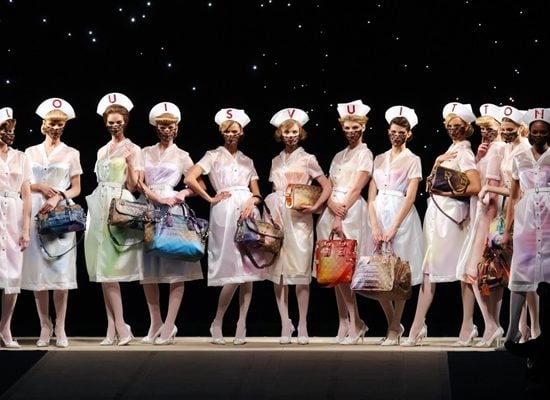To celebrate the start of New York Fashion Week, we’re taking a look at the increasingly intertwined worlds of art and fashion. Nowadays, art plays the muse while fashion gives it a different kind of exposure.
Over the last century artists and their artworks have become a popular source of inspiration for designers’ collections, and in return, through fashion, art has become more widely available—at least in terms of its price—to the public. In the 1960s Yves Saint Laurent crafted the iconic “Mondrian” day dress. Marc Jacobs’s tenure at Louis Vuitton saw many fruitful collaborations with artists, including Stephen Sprouse, Takashi Murakami, Richard Prince, and, most recently, Yayoi Kusama.
After Jacobs and Murakami cemented LV as the most artful leather goods brand, it seemed as if the label had perfected the art-fashion crossover formula. The introduction of Kusama’s collection for Louis Vuitton also coincided with the launch of her retrospective at the Whitney Museum. Books were published, parties were thrown, handbags were pre-ordered, and demand for Kusama’s works was higher than ever. But now that Jacobs is no longer in the picture, and it looks like Nicolas Ghesquiere is definitely here to stay, these razzle dazzle collaborations at Louis Vuitton may just fizzle out. Judging by Ghesquiere’s past work at Balenciaga, we don’t think it’s really his shtick.
Takashi Murakami, Panda (2003).
Photo courtesy of Galerie Perrotin.
On a much smaller scale, creative director Hedi Slimane—who in the past three years has spearheaded the total transformation of Yves Saint Laurent—received permission from California conceptual artist John Baldessari to reinterpret three of his paintings for his Fall 2014 collection. The results of the YSL-Baldessari collaboration are uniquely exclusive. The three dress designs, which will be sold in an extremely limited quantity of 10 each, were all hand-embroidered; one of each will live in the Baldessari archive, while the others will be scattered across YSL flagship stores worldwide.
Not to be outdone, Raf Simons—who is often compared to Slimane for the clear influence of punk and youth culture in their respective designs—collaborated with artist Sterling Ruby for his Fall 2014 men’s collection on his eponymous label. Slimane and Simons’s choices of artist are hardly arbitrary. Slimane lived in California for many years and the state became the subject of several photography exhibitions in which he was featured. Simons, for his part, has a deep-seated interest in youth movements and urban gangs that has glaring affinities with Ruby’s work. The recent collaborators had been in talks for several years; Ruby described his creation with Simons as a “natural thing to do.”
Page from Raf Simons book: Raf Simons Redux. Spring-Summer 2003. Consumed. Photographed by Mario Sorrenti.
Photo: Flickr/VictorSoto.
And it’s not just the high-end fashion houses that are collaborating with artists. Uniqlo, which is owned by Japanese retail giant Fast Retailing, partnered with MoMA for SPRZ NY, a collection of graphic T-shirts, shorts, and hoodies featuring artworks by famous artists (see “MoMA Licenses Warhol, Pollock, and Basquiat for Uniqlo’s Newest Fashion Line“). Jean-Michel Basquiat’s primitivist paintings, Keith Haring’s idiosyncratic figure drawings, or Andy Warhol’s Lifesaver-hued Campbell’s soup can screen print can be bought for less than $20—an astronomically lower price point than, say, a real soup can print by Warhol.
With NYFW around the corner, there is no doubt we’ll see art on the catwalk, but is this fashion-art combo just a new way of exploiting artists, consumers, or both? Does it get a pass under the guise of nobly peddling an otherwise unobtainable commodity, art, to the T-shirt-buying masses? Either way, both the artists and the brands are laughing all the way to the bank.
